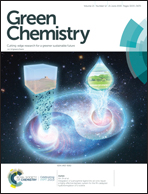Sustainable bioproduction of the blue pigment indigoidine: Expanding the range of heterologous products in R. toruloides to include non-ribosomal peptides†
Abstract
Non-ribosomal peptides (NRPs) constitute a diverse class of valuable secondary metabolites, with potential industrial applications including use as pharmaceuticals, polymers and dyes. Current industrial production of dyes is predominantly achieved via chemical synthesis, which can involve toxic precursors and generate hazardous byproducts. Thus, alternative routes of dye production are highly desirable to enhance both workplace safety and environmental sustainability. Correspondingly, biological synthesis of dyes from renewable carbon would serve an ideal green chemistry paradigm. Therefore, we engineered the fungal host Rhodosporidium toruloides to produce the blue pigment indigoidine, an NRP with potential applications in the dye industry, using various low-cost carbon and nitrogen sources. To demonstrate production from renewable carbon sources and assess process scalability we produced indigoidine in 2 L bioreactors, reaching titers of 2.9 ± 0.8 g L−1 using a sorghum lignocellulosic hydrolysate in a batch process and 86.3 ± 7.4 g L−1 using glucose in a high-gravity fed-batch process. This study represents the first heterologous production of an NRP in R. toruloides, thus extending the range of microbial hosts that can be used for sustainable, heterologous production of NRPs. In addition, this is the first demonstration of producing an NRP using lignocellulose. These results highlight the potential of R. toruloides for the sustainable, and scalable production of NRPs, with the highest reported titer of indigoidine or any heterologously produced NRP to date.



 Please wait while we load your content...
Please wait while we load your content...